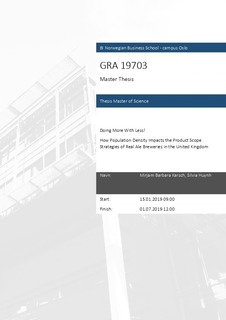| dc.description.abstract | This paper seeks to explore how an organization’s product scope evolves upon changing population
density. Considering prior academic achievements on both focal topics, our study provides
an exciting opportunity to enhance our knowledge by investigating the potential connection between
them.
In more detail, we contend that the competitive component of population density is more prevalent
in mature industries and narrow down our research setting accordingly. Against this background,
we draw upon arguments from different conceptualizations linking competition and innovation
to eventually construct our hypotheses for analyzing the effect of population density
on product scope expansions. Specifically, we claim that the two dimensions of an organization’s
product scope – namely product breadth and product depth – are positively affected by
population density.
To test these two assumptions under a quantitative research approach, we collected firm- and product
level data within the British real ale brewing industry between 2000 and 2018 upon which we
were able to construct our own dependent and explanatory variables. This mature market reveals a
considerable degree of heterogeneity on the number and organizational characteristics of active
firms as well as on the length and style dispersion of their product lines over time. It therefore
serves as a suitable research setting for examining the relationship between product scope and population
density.
We find that breweries facing a high population density are more likely to introduce new products
than organizations that launch under a low population density. Additionally, breweries are under
this scenario prompted to specialize their product launches in a few style categories. Whereas the
first observation on product breadth is in line with the reasoning given in previous literature, we
assert that organizations deliberately restrict their product depth to a few style categories owing
to handling of cost constraints, preventing of learning myopia, and erecting of entry barriers for
potential competitors.
Our study contributes to the field of strategy in several ways. First, it enhances the current literature
on density-dependence by drawing attention to the strategic behavior of alive firms. Whereas prior
density-dependence research merely focuses on firm birth and firm death, we investigate the strategic
moves of existing organizations with regards to their product scope introductions. Second,
we illustrate that population density exerts different effects on product breadth and product depth
and thus reconcile the two prevalent streams on innovation and competition. As such, we add to the present literature on product scope that rigorously elaborated on a variety of other critical determinants
of a firm’s product line. Third, our results emphasize that managers should maintain
dual awareness of both exploration and exploitation when deciding to proliferate their company’s
current product scope. In particular, launching additional products onto new market segments
within a few already applied style categories constitutes a reasonable and cost-efficient approach
to strategically behave in a mature business environment.
We anticipate that our study results are to a large extent generalizable towards industries with similar
features to those of the real ale brewing industry in the United Kingdom. As such, comparable
studies should confirm population density as an important determinant of product scope expansions
and should henceforward be explicitly considered when analyzing the product line decisions taken
by extant companies. | nb_NO |
